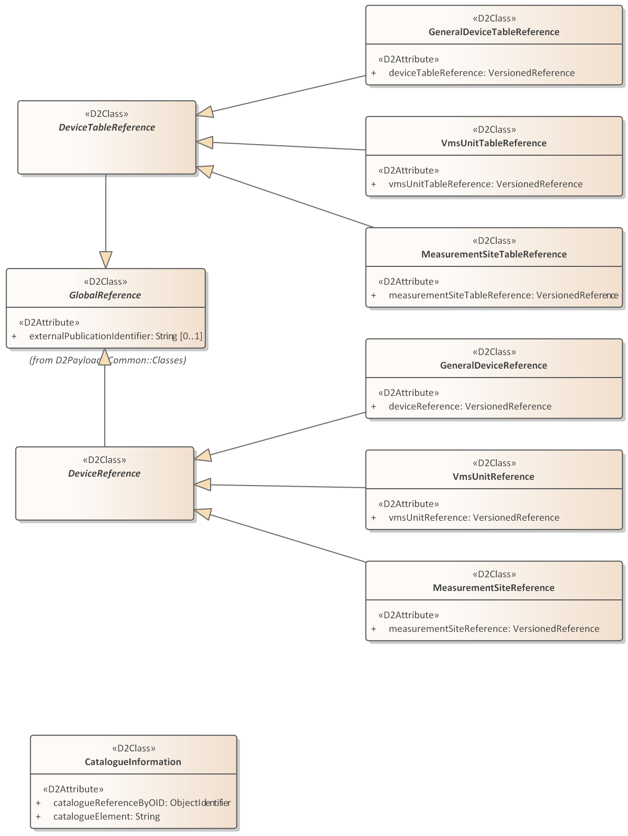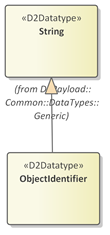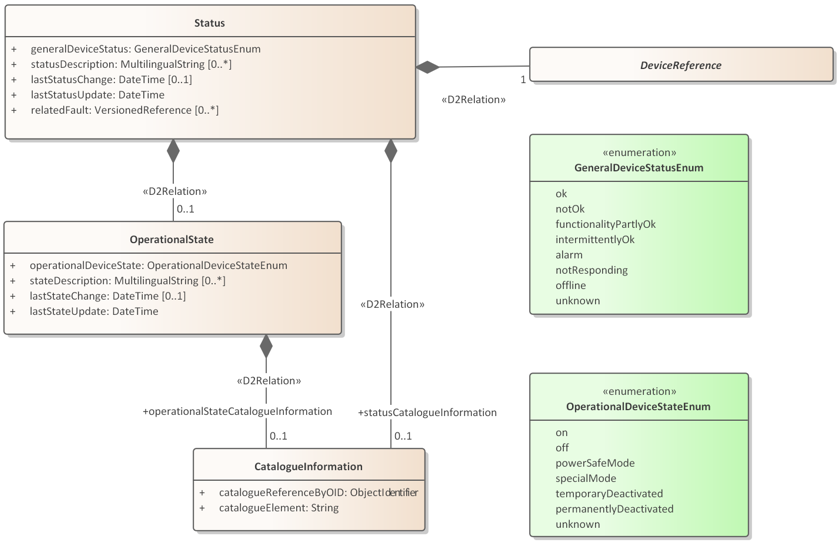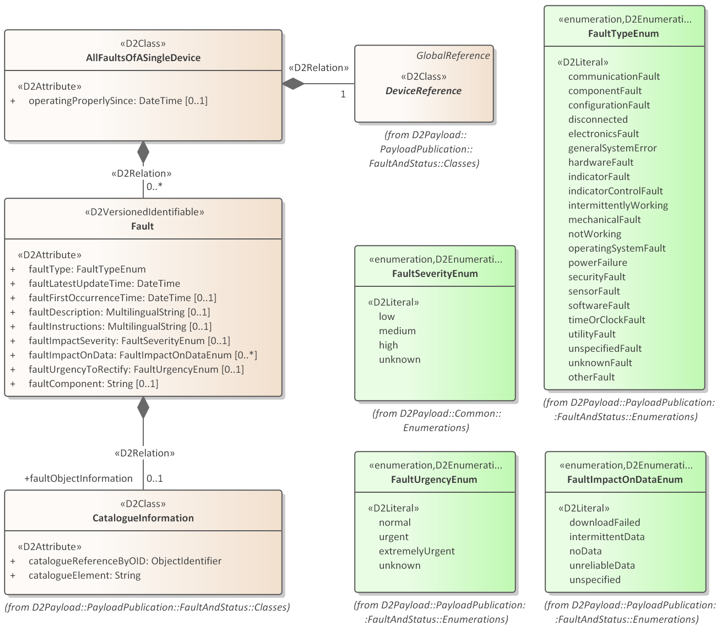System status and faults data model¶
The data model described here is a data model for the provision of the system status and for faults of traffic related infrastructure field devices. This will cover software-related faults as well as hardware-related faults.
Note
Further types of message categories, like warnings and information, may be defined in text form using the structure of this specification but are not specified itself in this document.
Note
In order to use precise language and to avoid ambiguous terms, the terms “system status” and “system faults” are referred to as “device status” and “device faults” in this clause; similarly “sub-devices” are referred to as “components”.
The data model is specified using UML. Data types for statuses and faults are specified in a general way, i.e. not explicitly linked to a specific traffic management context, e.g. VMS. Various contexts thus can share data types. The specification is based on DATEX II version 3.0.
New standardised fault and status definitions may be added at a later stage by means of the catalogue approach specified within this model. Appropriate means to ensure uniqueness will be applied, e.g. a registration authority, or amendments to and updates of this model.
However, considering the urgent needs of UAs, and being limited to cases where interoperability is not affected, private definitions of faults and status information are also supported.
Status or fault messages composed of instantiations of such fault and status information shall at least provide
information on the sending device, e.g. indicating its functional type;
the location of the sending device, either at implementation-specific events for static locations, or in every message for dynamic locations;
a time stamp indicating the time when a fault was detected, or when the status was evaluated;
the version number of the message specification.
Modelling principles¶
The data model for fault and status information shall be included in a package of stereotype «D2Namespace» with name “FaultAndStatus” and sub packages as depicted in this figure.

Information about the devices themselves being updated with low frequency and with focus on its location reference shall be specified by one of the following methods:
Usage of the ‘DevicePublication’ for devices of any type as specified below
Usage of existing DATEX II structures that provide a versioned reference for a specific type of a device. Candidates are for example the ‘MeasurementSiteTablePublication’ currently being specified in EN 16157 part 5 or the ‘VmsTablePublication’ currently being specified in EN 16175 part 4
Status and fault information for a device shall be provided in general terms by using specified enumerated values, see below. To provide more precise status and fault information, a reference to a specific catalogue by using an object identifier (OID) may be provided.
«D2Package» DevicePublication¶
With the “DevicePublication” package illustrated in Figure 2, devices and its properties in terms of low frequently changing information may be specified either by a collection of devices or by using a table structure.
A single device may use this structure to transmit information about itself to a central system by including exactly one device in the publication.
In a centre-to-centre communication use case, tables may be used to arrange device information in an ordered structure. When using the table structure, each version of a device table must always contain a snapshot of all relevant devices for this table. Devices no longer included in the table are treated as no longer existent.
DevicePublication class
The “DevicePublication” class shall contain either information on single devices or tables of device information. These two concepts shall not be merged within the same publication instance.
Header information presented in Figure 2 on the “DevicePublication” class shall be provided.
DeviceTable class
The “DeviceTable” class may be used to arrange a snapshot of a number of devices in a table structure.
The identifier of an accountable authority may be provided for the device table in case the information source is different from the publication supplier.
Device class
The “Device” class shall be of stereotype “D2VersionedIdentifiable” to be referenced in the “FaultPublication” or “StatusPublication”.
The type of the device, referring to the enumeration “DeviceOrSystemTypeEnum”, as well as the last update time of the device information shall be provided. A point location of the device using the “LocationReference” package specified in EN 16157-2 shall be provided.
The identifier of an accountable authority may be provided for the device in case the information source is different from the publication or the device table source.
«D2Package» StatusPublication¶
The “StatusPublication” package illustrated in the following figures shall be used by a supplier to provide information about the status of single devices or for a table of devices.
StatusPublication I
StatusPublication II
The StatusPublication class
The “StatusPublication” class shall contain either single device status information or tables of device status information for multiple devices.
These two concepts shall not be merged within the same publication instance.
Header information presented in StatusPublication I on the “StatusPublication” class shall be provided.
The StatusOfAllDevicesFromTable class
By using the “StatusOfAllDevicesFromTable” class, status information for devices contained in an existing (previously transmitted) device table may be provided. The table shall be referenced using the “DeviceTableReference” class.
The Status class
The “Status” class shall be used to specify a general status for the device, with status values taken from an enumerated list.
The status may refer to one or more specific faults.
An additional information about the operational status of the device may be provided by using the class “OperationalState”.
The “Status” class provides the following attributes with the denoted semantic:
“generalDeviceStatus”: A general specification of the device status.
“statusDescription”: A description for the device status.
“lastStatusChange”: A timestamp referring to the last change of the device status.
“lastStatusUpdate”: A timestamp referring to the latest update of the current status information.
“relatedFault”: A relationship to one or more specified faults, if feasible, using the versioned identifiable mechanism specified in EN 16157-1.
Note
The “Status” class may be used to transmit information from a specific device to some central system as well as transmit information between central systems. In the first case, information like “notResponding” or “offline” usually cannot be transmitted by the device itself for obvious reasons. This kind of information can only occur in the second case and usually results from central or operator-related post-processing.
By using the “CatalogueInformation” class by role “statusCatalogueInformation” it is possible to refer to a specific device status element out of a specific catalogue.
The OperationalState class
In addition to the general device status, an operational state may be provided by using the “OperationalState” class. A description and time stamps for the last update and the last change of the operational status may be provided. The operational states visible in Figure 4 be supported.
By using the “CatalogueInformation” class by role “operationalStateCatalogueInformation” it is possible to refer to a specific operational state element out of a specific catalogue.
«D2Package» FaultPublication¶
The “FaultPublication” package illustrated in the following figures shall be used by a supplier to provide information about the fault(s) of single devices or for tables of faults for multiple devices.
FaultPublication (part I)
FaultPublication (part II)
The FaultPublication class
The “FaultPublication” class shall contain either fault information of a single device (“AllFaultsOfASinlgeDevice”), or tables of these for multiple devices. These two concepts shall not be merged within the same publication instance.
Header information presented in Figure 5 on the “FaultPublication” class shall be provided.
The FaultsOfAllDevicesFromTable class
By using the “FaultsOfAllDevicesFromTable” class, fault information for all devices contained in an existing (previously transmitted) device table may be provided. The corresponding device table shall be referenced using the “DeviceTableReference” class.
The AllFaultsOfASingleDevice class
With the “AllFaultsOfASingleDevice” class, fault information for one specific device shall be provided. A publication shall comprise all faults that have occurred on the device until the time of publication, and that are not yet cleared.
NOTE Usually, this table will contain zero entries (to indicate that the device is free of faults) or one fault (at the point when the fault is reported). In case a fault is not yet rectified and another fault occurs, this table can provide more than one fault.
The corresponding device shall be referenced using the “DeviceReference” class.
The Fault class
By using an instance of this class, the FaultTypeEnum-information, visible in FaultPublication (part II), shall be provided.
In addition, the following information about a fault may be specified:
the time of the first occurrence of that fault (especially if the fault occurred multiple times);
a fault description;
An instruction to rectify this fault;
severity of the impact specified by one of the levels in FaultSeverityEnum, see FaultPublication (part II);
Its impact on the delivery of data by one of the elements in FaultImpactOnDataEnum, see FaultPublication (part II);
Its urgency to rectify (normal, urgent, extremely urgent or unknown);
The component /sub device in which the fault occurred, if any.
«D2Package» Classes¶
The “Classes” package illustrated in the following figure provides classes for the reference mechanism of existing DATEX II publications as well a class to reference elements from catalogues.

Reference-related classes
To refer to a device or to a device table, a specialisation of the “DeviceReference” or “DeviceTableReference” class shall be used. The specialisation depends on the device object that should be referenced:
A device or device table specified with the “DevicePublication”, may be referenced by the “GeneralDeviceReference” or “GeneralDeviceTableReference” classes.
A device or device table specified with the “VmsTablePublication” (EN 16157 part 4) may be referenced by the “VmsReference” or “VmsTableReference” classes.
A device or device table specified with the “MeasurementSiteTablePublication” (EN 16157 part 5) may be referenced by the “MeasurementSiteReference” or “MeasurementSite TableReference” classes.
CatalogueInformation class
With the “CatalogueInformation” class a reference to an element out of a catalogue shall be provided.
«D2Package» DataTypes¶
The “DataTypes” package is illustrated in the following figure.





